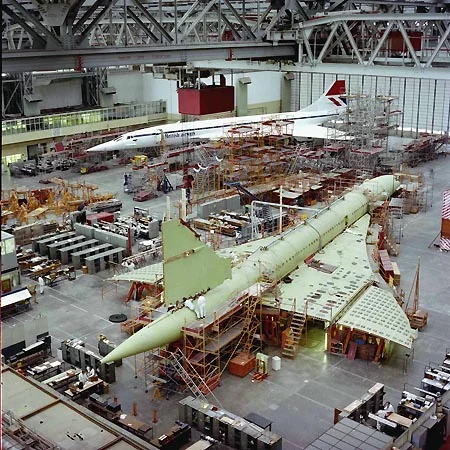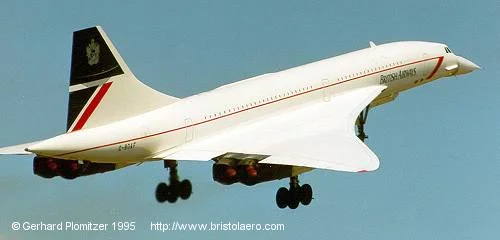Concorde Alpha Foxtrot:
The last Concorde to be
built and the last to fly
20th April 1979
Concorde 216 made it first flight from Filton on this date. It was painted white and was registered as G-BFKX. Both it and the second last example (214, G-BFKW) were built with no customer order. It had been hoped that either Singapore Airlines or British Caledonian would purchase them, but this did not happen. Eventually a deal was agreed to sell it to British Airways, along with 214.
In preparation for sale to British Airways, 216 was re-registered as G-N94AF, which was essentially an American registration with a British registration prefix. This unusual format was applied to most British Airways Concordes, as part of an arrangement with Braniff International Airways to fly to Dallas. It would work like this; a Concorde would fly a BA flight from London to Washington-Dulles. Then, it would be 'sold' to Braniff, the G- prefix would be removed, and a Braniff crew would then fly subsonic to Dallas and back. On return to Washington, it would be handed back to BA. As it turned out, this arrangement ceased before 216 was delivered, so it never appeared in these markings.
12th June 1980
216 was re-registered as G-BOAF for sale to British Airways on this date, and flown from Filton to Heathrow on delivery to British Airways the next day. It had made ten flights up to its delivery flight.
A first day cover was issued for the delivery flight and carried on board. Strangely, it still referred to the previous registration (G-N94AF).
1st January 1983
G-BOAF made the fastest Trans-Atlantic crossing by a commercial aircraft on a flight from New York to London. The total flying time was 2 hours, 56 minutes and 35 seconds. It held the record for five years, when another Concorde shaved one minute and 20 seconds off the time.
1st April 1989
G-BOAF left Heathrow on a circumnavigation of the world. By the time it had returned, it had covered 38,343 miles.
12th April 1989
During a flight from Christchurch in New Zealand to Sydney in Australia, G-BOAF lost part of the upper rudder. This was the first occurrence of rudder separation failure on a Concorde. Although a bang was heard while climbing through 44,000 feet (at Mach 1.8), there was no noticeable effect on the flight characteristics, and the crew only found out when the controller at Sydney mentioned it to them when they were taxiing in. New rudders were fitted to the fleet after the same incident occurred on other Concordes.
May 1993
G-BOAF was the first British Airways Concorde to receive a new £1 million cabin upgrade, which included new leather seats.
10th June 1997
G-BOAF was the first British Airways Concorde to be painted in the airline's 'Chatham Dockyard' livery. This was one of the 'Utopia' schemes, a series of ethnic designs from around the world painted on the tails of BA aircraft. All Concordes received the 'Chatham Dockyard' livery, which included a stylised section of a Union Flag. In 2001, the ethnic designs were replaced by the Chatham Dockyard livery across the entire BA fleet. As 216 was the first in this livery, it featured prominently in publicity material at the time.
25th July 2000
An Air France Concorde crashed shortly after taking off from Paris Charles de Gaule Airport. The cause of the accident was attributed to a small metal panel, which had dropped from the previous aircraft to use the runway. This caused a tyre to burst, sending rubber fragments in all directions. One fragment caused the under-wing skin to rupture, which led to a fuel leak. An electrical spark in the wheel well ignited the fuel, and the flames were sucked into the engines. Both engines on one side suffered a flame-out, and the aircraft could not achieve enough height and crashed. Within hours, Air France grounded their fleet of Concordes. As a mark of respect, British Airways cancelled their evening Heathrow-New York and return flights.
January 2001
A series of modifications were developed, each one dealing with a specific area in the chain of events that led to the Paris crash. G-BOAF was chosen as the development aircraft for these fixes. NZG (non-zero growth) tyres were fitted, to prevent tyre disintegration. The fuel tanks were lined with Kevlar, to prevent rupturing. Electrics in the wheel well were insulated. At the same time, an Olympus engine was tested and proved to be able to cope with fuel leak after the liners were fitted
Prior to the accident, British Airways had been planning a complete cabin refurbishment. New seats, carpets and upholstery were included in the work to get Concorde back in the air. The seats were considerably lighter, offsetting the increase in weight from the fuel tank linings.
19th June 2001
Modifications to G-BOAF were complete, and the aircraft was rolled out of the hangar at Heathrow. After a series of system checks, 216 made a taxi test around Heathrow on 9th July.
17th July 2001
G-BOAF took off from Heathrow, the first British Concorde to fly after the grounding 11 months earlier. After a short flight, it landed at RAF Brize Norton, where it remained for three days of ground-based tests.
11th September 2001
G-BOAF made the first operational assessment flight for the return to service. With a cabin full of BA staff, it flew to the Bay of Biscay to fly supersonic. When 216 landed back at Heathrow, the passengers and crew learned of the terrorist attack underway in the USA, when airliners were flown into the World Trade Centre in New York and the Pentagon. This single event caused a sharp downturn in the airline market, which eventually led to the withdrawal of the Concorde fleet two years later.
22nd October 2001
216's last operational assessment flight before the resumption of commercial flights was to New York. This was the first Concorde flight to the USA since the grounding.
7th November 2001
Concorde returned to commercial service, when British Airways and Air France resumed flights to New York. To coincide with this, G-BOAF flew Prime Minister Tony Blair from London to Andrews Air Force Base to meet President George W. Bush.
1st December 2001
G-BOAF flew the first service to Barbados since the grounding. Up to the withdrawal in 2003, Barbados and New York were the only scheduled destinations for BA Concordes.
26 November 2003
Concorde Alpha Foxtrot G-BOAF flew into Filton in November 2003. She was the last Concorde ever to fly.
7th February 2017
Concorde Alpha Foxtrot made her final journey across Filton Airfield to her brand new purpose-built hangar, ready to go on display at Aerospace Bristol.
17th October 2017
Aerospace Bristol opened its doors to the public, with Concorde Alpha Foxtrot as the showcasing centrepiece.
Concorde's final journey
On 7th February 2017, Aerospace Bristol welcomed Concorde Alpha Foxtrot - the last Concorde to be built and the last to fly - to her new purpose-built home. The complex move was conducted with the greatest care by engineers from British Airways and Airbus, who towed the iconic aircraft across Filton Airfield and up a ramp into the new purpose-built hangar at Aerospace Bristol.



